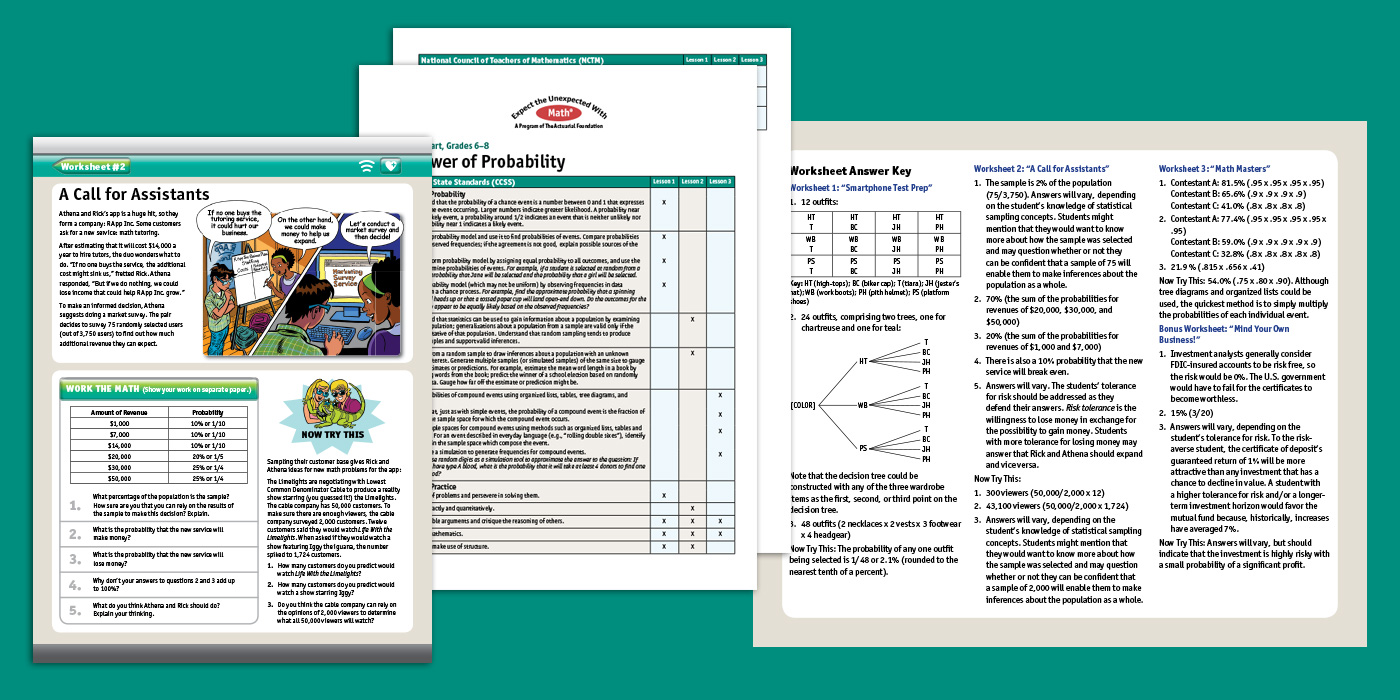Simple Probability and Sampling
In this lesson, students will use a sample to make predictions about a population and add the probabilities of multiple outcomes to determine the probability of an event.
Preinstructional Planning
Objectives
Students will:
- Understand that proportions can be used to make predictions about a population based on a sample
- Identify the difference between outcomes and events
- Add the probabilities of the outcomes that are part of an event to determine the probability of an event
Materials
- One six-sided die (for a demonstration)
- Calculators
- The Power of Probability Worksheet: A Call for Assistants printable
- Answer Key: The Power of Probability printable
- Standards Chart: The Power of Probability printable
- Optional: Online Probability Challenge
- Optional: The Power of Probability Classroom Poster printable
During Instruction
Set Up
1. Make a class set of The Power of Probability Worksheet: A Call for Assistants printable.
2. Print a copy of the Answer Key: The Power of Probability printable.
3. Optional: Hang a copy of The Power of Probability Classroom Poster printable in your classroom.
Lesson Directions
Introduction to Basic Probability and Sampling
Step 1: Show a single six-sided die to the class. Ask what the possible outcomes are. Record the outcomes on the board. Ask the class to calculate the probability of each outcome as a fraction (1/6 for each). Indicate that when the probabilities of all individual outcomes are added together, the sum is 1.
Step 2: Ask what the probability of rolling an even number is. Students should indicate that the probability is 1/2 or 50%. They may calculate this by writing the number of favorable outcomes (3) over the total number of outcomes (6) to get 3/6, which should be reduced to lowest terms (1/2). Show how they could also determine this by adding the probability of each even outcome (1/6 + 1/6 + 1/6) to arrive at 3/6 or 1/2 or 50%.
Step 3: Explain that the even outcomes here are 2, 4, or 6. Rolling an even number is called an event. The sum of the even outcomes equals the probability of an event. If necessary, repeat with other examples, such as the probability of rolling a number other than a 3, the probability of rolling a number less than 3, etc.
Guided Practice
Step 4: Individually or in pairs, ask students to calculate the following probabilities when rolling a six-sided die:
- Rolling a number more than four (2/6 or 1/3. 5 and 6 are the favorable outcomes)
- Rolling any number but 2 (5/6. 1, 3, 4, 5, and 6 are the favorable outcomes)
Also, ask students to evaluate the following statement: Janet said she was 110% sure she aced the last math test. For both problems, students should share answers and explain their thinking to the class.
Independent Practice
Step 5: Distribute The Power of Probability Worksheet: A Call for Assistants printable and calculators. Read the introduction and review the facts with the class. Ask students to complete the worksheet. Explain that the bonus question requires them to apply what they learned about probability from The Power of Probability Worksheet: Smartphone Test Prep printable from the lesson on basic probability.
Step 6: Check for Understanding: Use your copy of the Answer Key: The Power of Probability printable to review answers as a class. Make sure that the review includes a discussion of how proportions are used to make predictions about the population as a whole by using the results of a poll of a sample of the total customer base (e.g., 12/2,000 = x/50,000) and the validity of doing so.
Lesson Extensions
Have students use the Online Probability Challenge to practice using probability skills for real-life purposes. This interactive online activity challenges students to use probability to help Rick and Athena plan a summer concert tour. This activity can be used as an in-class lesson activity or an out-of-the-classroom extension.



